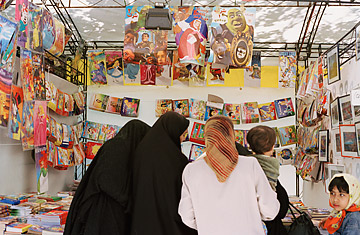
Women shop in Shiraz, Iran
Labor unrest and economic anxiety may not be among the headlines coming out of Iran since the controversial presidential election of June 2009, but they could turn out to be critical factors in the fate of the Islamic Republic. Indeed, the regime is so sensitive about the country's well-being that it has been obfuscating economic statistics — or simply not reporting them.
Every week, unofficial sources of information in Iran (that is, blogs and social media) report labor problems. This week, there was a report about a privately owned industrial-parts company in Isfahan, Iran's third largest city, that has failed to pay 200 of its employees for the past seven months. About 80 angry workers forced their way into a board meeting, compelling company managers to hastily promise an initial payment within days and a settling of all debts by the end of the Iranian year in mid-March — with New Year bonuses as an added sweetener.
Similar promises were also reportedly made last week by the director of a large steel plant, also in Isfahan, after workers announced the beginning of a hunger strike to protest large discrepancies in pay. Reassuring words from the director were followed by a tour of the plant by security staff, who demanded that the organizers of the strike be turned in to company management.
Reports toward the end of last month told of telecommunications workers protesting in the south-central city of Shiraz for three consecutive days over 13 months of unpaid wages, numerous factories operating at 20% to 30% capacity and up to 2,000 layoffs in the power industry as three major companies began cost-cutting measures. Meanwhile, mine workers in Gorgan province have reportedly gone unpaid for six months, their employers failing to pay state insurance and allowing conditions to drop below legal minimums for health and safety. One report by a nongovernmental organization said that Iran's power industry is close to ruin because of $5 billion in unpaid government debts. A spokesman for the electricity industry syndicate claimed that up to 900,000 workers wholly reliant on Iran's energy and oil ministries were on the brink of unemployment and that numerous companies had already gone bankrupt.
Such stories remain mostly confined to the media outlets of human rights and labor organizations, whose members operate under perpetual fear of arrest and intimidation. Iran's official media continue to portray Iran as a success story. Indeed, so does President Mahmoud Ahmadinejad. However, at Ahmadinejad's most recent press conference, in mid-February, a reporter asked the President about the omission of third-quarter GDP growth figures from the latest report by Iran's Central Bank. Ahmadinejad simply dismissed the importance of interim figures as "mere estimates" and claimed that current growth stood at 6.9%. Significantly, the newspaper World of Industry, not a government organ but one that caters to economists and technocrats, pointed out that the following day, Ahmadinejad's figure corresponded with one from two years ago, when Iran was enjoying a period of record oil prices.
The last available official figures put Iran's economic growth at just 2.5% for the first half of the Iranian year (March-August 2009) — far short of the 8% targeted in Iran's fourth Economic Development Plan, which ends this year. Despite the apparent unknowability of third-quarter statistics, figures closely associated with growth — capital investment and permits for new construction projects — showed double-digit declines. Overall unemployment stood at 11.3%, while the out-of-work figure for those between the ages of 15 and 24 was estimated to be just over 24%. Real unemployment figures, however, are suspected to be significantly higher, given that large numbers of the unemployed do not register with the Labor Ministry. Says an Iranian journalist, who asked for anonymity: "They have manipulated the definition of who is jobless so they can keep the figure close to 10%. But now every family has one jobless person in their home."
Five years ago, Ahmadinejad was elected as a problem solver, an engineer who would clear away old obstacles to a functioning and just economy. An initial flood of oil-fueled liquidity and openhanded lending at the beginning of the Ahmadinejad era has given way to a stagnant property market and tight limits on bank lending in an effort to rein in prices. Ahmadinejad also dissolved economic-planning organizations and dismissed officials with economic expertise. Managers in Iran's near paralyzed manufacturing sector now face the immediate problem of how to fill the gaps in their end-of-year accounts under a cloud of unpaid government debts and declining demand.
The rosy talk out of the President's office does not match up with the realities faced by ordinary Iranians. "They look at their pockets and find nothing positive there," says the Iranian journalist. "They cannot believe all those optimistic figures given by the government. The government says that inflation was less than 30%, but they go to the grocery store and find everything is double and triple the price that it was four years ago."
